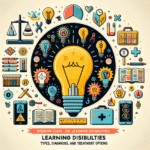
Revolutionizing Education: The Essential Role of Technology in Assisting Learners with Disabilities
Introduction
In a world bustling with technological advancements, we find ourselves on the cusp of a revolutionary era in education. Specifically, the intersection of technology and inclusive learning is creating remarkable opportunities for students with disabilities. Revolutionizing education: the role of technology in assisting learners with disabilities cannot be overstated, as it holds the promise of bridging gaps and fostering an environment where every learner can thrive. With the use of innovative tools and resources, educators are better equipped to address the varying needs of their students, offering personalized learning experiences that empower individuals to succeed.
The Landscape of Education for Learners with Disabilities
Understanding the Challenges
Before delving into the transformative power of technology, it’s critical to ground ourselves in the reality faced by learners with disabilities. According to the National Center for Learning Disabilities, approximately 1 in 5 students in the U.S. experiences some form of learning disability. These challenges may range from cognitive and physical disabilities to sensory impairments that can impede a child’s education.
The Shift Towards Inclusion
Inclusion is not merely a buzzword; it is a necessary evolution in educational practices. With the Individuals with Disabilities Education Act (IDEA) emphasizing the right for all students to receive a free, appropriate public education, schools are critically evaluating how they can adapt their teaching methods to embrace inclusivity, giving rise to the question: how can technology facilitate this transition?
Innovative Technologies Enhancing Learning
Assistive Technologies: The Game Changers
1. Text-to-Speech Software
Text-to-speech software is one of the leading examples of how technology supports learners with disabilities. Tools like Kurzweil 3000 and Read&Write enable students with reading difficulties to grasp text-heavy materials by converting written words into spoken language. This not only enhances comprehension but also promotes independence.
Case Study: Kurzweil 3000 in Action
A school district implemented Kurzweil 3000 for a group of students with dyslexia. Teachers reported a significant increase in reading comprehension and overall confidence amongst the students. This case illustrates that revolutionizing education: the role of technology in assisting learners with disabilities indeed can lead to measurable improvements in academic performance.
2. Speech Recognition Tools
Speech recognition software, such as Dragon NaturallySpeaking and built-in features on devices, allow learners with physical disabilities to dictate their thoughts instead of writing them out. This technology opens the doors for students who may struggle with traditional writing tasks.
Case Study: Leveraging Speech Recognition
In a recent initiative at a high school catering to students with physical impairments, the use of speech recognition software resulted in a 50% increase in assignment completion rates. Students reported feeling more engaged, showcasing the profound impact of assistive technologies.
3. Accessible Learning Management Systems (LMS)
Platforms like Google Classroom and Canvas are progressively incorporating accessibility features, ensuring students with disabilities experience an equitable learning environment. Integrating tools such as screen readers and customizable content layouts allows learners to engage more fully in their courses.
Interactive Learning Interfaces
1. Virtual Reality (VR) and Augmented Reality (AR)
VR and AR can create immersive learning experiences that cater to diverse learning styles. For instance, simulations in a science class can provide visually impaired students with tactile feedback and auditory guidance, marrying technology with sensory learning.
Case Study: Exploring Physics through VR
A middle school utilized VR to teach complex physics concepts to a group of students with varying disabilities. The ability to visualize abstract concepts in a three-dimensional space helped students grasp challenging ideas more easily. Feedback from participants highlighted their increased understanding and enjoyment, exemplifying the revolutionizing education concept.
2. Gamification
Educational games designed for learners with disabilities offer a unique approach to learning. These games often incorporate essential skill-building activities while reducing the stress and anxiety associated with traditional assessment methods. Tools like Kahoot! can provide inclusive assessments that keep all learners engaged.
Data-Driven Decision Making
Using Analytics to Support Individual Needs
Educational institutions are harnessing data analytics to identify the specific challenges faced by students with disabilities. By analyzing this data, educators can tailor content, pacing, and assessments to better serve individual learning needs.
The Importance of Training Educators
While technology is a powerful ally, its successful integration into educational settings demands training for educators. Professional development programs focusing on assistive technologies and inclusive teaching strategies are essential for a successful transition.
Building Community and Collaboration
Fostering a Supportive Ecosystem
Creating an inclusive educational environment is not solely within the purview of teachers; it thrives on collaboration among parents, educators, and technology developers. Establishing a dialogue among these groups can lead to innovative solutions tailored to unique challenges faced by students with disabilities.
Raising Awareness and Advocacy
Organizations dedicated to disability rights play a crucial role in raising awareness about the importance of accessible education. Their efforts can spark essential conversations about revolutionizing education: the role of technology in assisting learners with disabilities, driving momentum for change on a larger scale.
Conclusion: A Call to Action
As we reflect on revolutionizing education: the role of technology in assisting learners with disabilities, we can confidently say that technology is transforming how educators can support their students. The current landscape offers unprecedented opportunities to empower learners with disabilities, fostering a sense of belonging and success in their educational journey. The challenge remains for stakeholders—educators, policymakers, parents, and tech innovators—to unite in creating a tapestry of support that celebrates diversity and inclusion.
Encouragement lies in the hands of every reader—let’s challenge ourselves to advocate for inclusive practices, embrace technological tools, and ensure that education is a right for all, fueled by innovation.
FAQs
1. How can assistive technology be integrated into everyday classroom activities?
Assistive technology can be seamlessly woven into lesson plans by utilizing tools such as interactive whiteboards, tablets, and software that supports diverse learning styles, making lessons more engaging and accessible for all students.
2. What types of disabilities can benefit from educational technology?
Various disabilities, including learning disabilities, physical impairments, visual and hearing impairments, and autism spectrum disorders, can benefit significantly from tailored educational technology solutions.
3. Are there specific training programs for educators focusing on assistive technology?
Yes, many professional development programs and workshops are available that focus on integrating assistive technologies into the classroom effectively, helping educators become proficient in utilizing these resources.
4. How do parents play a role in the adoption of technology for students with disabilities?
Parents play a vital advocacy role in identifying their child’s needs, collaborating with educators to tailor learning experiences, and encouraging the use of assistive technologies at home for practice and reinforcement.
5. What are some cost-effective solutions for schools with limited budgets?
There are several free or low-cost tools, such as Google’s accessibility features, open-source software, and OTT (Over-The-Top) services that can be implemented to support learners with disabilities without a massive financial investment.
6. How does technology promote independence among students with disabilities?
By providing tools that allow for self-paced learning and personalized approaches to content, technology empowers students with disabilities to take ownership of their education, fostering confidence and independence.
In the ever-evolving landscape of education, the integration of technology remains a beacon of hope for many learners with disabilities. Let us champion these advancements and strive for a future where revolutionizing education is synonymous with inclusivity, opportunity, and success for all.









